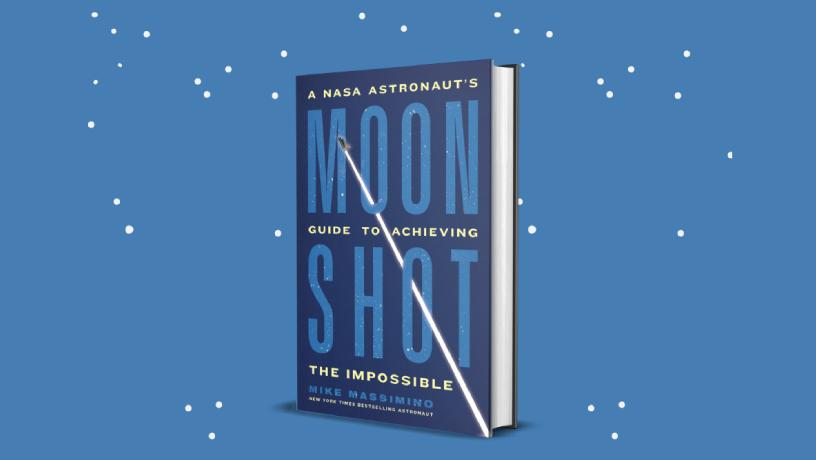Astronaut Stories and Life Lessons from Professor Mike Massimino
In a new book, mechanical engineering professor Mike Massimino shares stories and lessons from his time as a NASA astronaut.

Credit: Jeffrey Schifman
Next mission? To achieve the impossible.
In his new book, Moonshot: A NASA Astronaut’s Guide To Achieving the Impossible, former NASA astronaut and current professor of professional practice Mike Massimino BS’84 writes about lessons learned on his journey from a kid on Long Island to an astronaut going on spacewalks to repair the Hubble Space Telescope.
The book, his third to date, is packed with stories and insights from Massimino’s life and career, including numerous rejections from NASA’s astronaut program, sending the first tweet from space, and appearing on the TV series The Big Bang Theory. He offers strategies for tough situations like facing long odds, dealing with failure, handling mistakes, and deciding when to change course.
Massimino has been part of the Columbia Engineering community since he enrolled more than 40 years ago. After working in the private sector, earning two M.S. degrees and a Ph.D. at MIT, and spending 18 years as an astronaut, Massimino returned to Columbia in 2014.
We sat down with Massimino to discuss how Columbia Engineering prepared him for his career as an astronaut and how he brings that expertise into the classroom to train the next generation of Columbia Engineers.
The Apollo 11 moon landing first inspired you to become an astronaut, but you were still young when that dream faded. What reignited your ambition to make it to space?
The movie The Right Stuff came out when I was a senior here at Columbia in January 1984. That rekindled my interest, and it made me realize what was really important to me. I was just mesmerized sitting there watching the teamwork between the astronauts and space flights. I thought to myself, ‘I don't know how I could ever pull this off, but I still want to grow up to be like Neil Armstrong.’
How did your time as an undergraduate at Columbia Engineering prepare you for becoming an astronaut?
I studied industrial engineering, which provided me with the ability to solve problems. Sometimes you don't even understand what the heck is going on at first. What an engineering education shows you is how to make assumptions and look at problems from a different perspective to figure out a way to engage the problem so you can solve it.
One of the lessons you discuss in Moonshot is about knowing when to pivot. What was it like to leave NASA and return to the classroom?
At first I missed it. I was like, ‘Oh, what did I do? I left my dream job!’ It was really hard to leave, but I've gotten more comfortable with it in the last couple of years. It wasn't an easy transition for me, but I feel like I'm still contributing to the space program through my work at Columbia, at the Intrepid Museum, and by speaking and writing.
How do you bring your experience as an astronaut into the classroom?
I try to give real-world examples where things need to work. There may be a lot of things theoretically involved in solving a certain problem, but I push my students to think about what’s really important. For example, in the class I'm teaching right now — aerospace human factors — we have a project on display design for different space technologies, like a high-altitude balloon, a robotic astronaut, and an assistant for spacewalking astronauts.
There are millions of things you can show the human operator, but what we try to figure out is what are the most important things you need to show the person who’s interacting with the technology.
You helped establish the Columbia Space Initiative, a student group on campus. What is the mission of this group and why is it important?
The mission is to cultivate the next generation of space leaders and expand student access to space. It's grown exponentially since we started in 2015. They now have 300+ members and have had experiments go to the space station. This gives students hands-on spaceflight experience and also energizes them about the future opportunities in the space industry.

